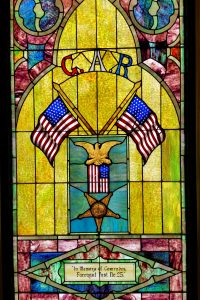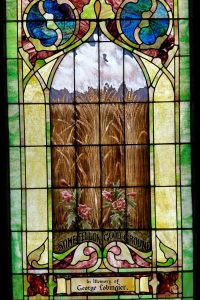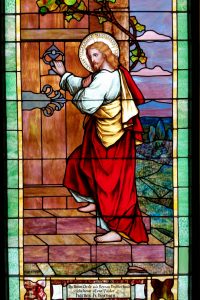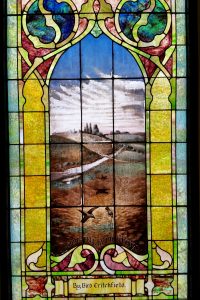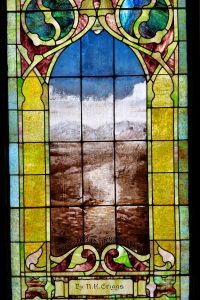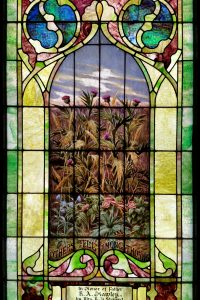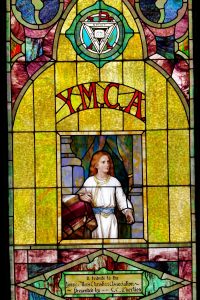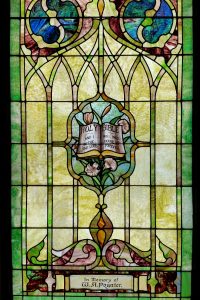The stained glass windows in this hall were moved from the third building of the congregation located at the northeast corner of 14 th and M Streets. These windows were designed and made by the Jacoby Art Glass Company of St. Louis. For over seventy years the Jacoby Studio produced windows for cathedrals, churches, homes and businesses across the mid section of the United States. In Nebraska, the most notable Jacoby windows are in St. Mark’s Pro-Cathedral in Hastings.
G.A.R.”In Memory of Comrades, Farragut Post No. 25”
This window is adorned with 45-star flags, the G.A.R. badge and cost $60.
The Grand Army of the Republic embraced veterans who served on the Union side during the Civil War. A total of 356 posts were organized in Nebraska from 1866 – 1908. The Lincoln post was named for Admiral David Farragut, the first senior officer of the U.S. Navy during the Civil War.
Parable of the Sower: “Some Fell on Good Ground”
In Memory of George Lobinger
Four windows portray the Parable of the Sower. The parable is found in all the Synoptic Gospels (Matthew, Mark and Luke) as well as in the Gospel of Thomas and can be interpreted to illustrate different reactions to the Gospel message.
This window, depicting seeds that fell on fertile soil, was given in memory of George Lobinger, an early member of this church. Born in Pennsylvania in 1832, he studied law and later prepared for the ministry at Hiram College when James A. Garfield (20th president of the United States) was an instructor there. Lobinger preached in both New York City and Washington, D.C. before moving to Thayer County, Nebraska where he served as a County Judge for 4 terms before coming to Lincoln.
This window, which cost $50, was already installed in the church when Lobinger died in 1909, so the memorial with his name was leaded onto the stained glass window.
“Christ Knocking at the Door”
By Union Circle and Berean Brotherhood in Honor of Our Pastor, Harvey H. Harmon
This window is a familiar interpretation of Christ standing and knocking on the door of the unbeliever’s heart and is taken from Revelation 3:20.
Harvey Horace Harmon was born April 25, 1875 in Auburn, Nebraska. He attended Cotner College and graduated from the University of Nebraska in 1896. After serving other pastorates he was called to our church in 1906. During his pastorate the congregation grew from 350 members to about 1,250 in 1923. He was granted a six month leave of absence to serve in World War I and subsequently served as pastor of National City Christian Church in Washington, D.C., the first pastor in the great building on Thomas Circle.
This window was given by the “senior” women’s and men’s Bible study groups of the church.
Parable of the Sower: “Some Fell on by the Wayside”
By Bird Critchfield
In this window the seed has fallen beside the path and symbolizes those who hear but do not understand.
Ashford Bird Critchfield was born and married in Ohio and taught school there before moving to Cass County, Nebraska, where he farmed and taught school. He served 2 terms as County Clerk and moved to Elmwood in 1892. He became a prominent lumberman and moved his family to Lincoln in 1902. He served as deacon and chairman of the building committee for the 14th and M Street church and died suddenly at home November 2, 1912.
Parable of the Sower: “Others Fell on the Rocky Ground”
By N. K. Griggs
In this third window the seed has fallen onto thin rocky soil where it cannot develop deep roots to sustain life.
Nathan Kirk Griggs was born in Frankfort, Indiana in 1844 and died in Sepatember, 1910 while on a trip from Lincoln to Alliance. He was prominent in early politics in the state and served several times as chairman of the Republican state convention. He served 2 terms in the state senate and was appointed by President Ulysses Grant as U.S. consul to Chemnitz, Germany.
Griggs joined First Christian in 1893 and served as a respected Sunday School teacher and elder. He delivered an important address at the Pittsburg Convention of the Disciples of Christ in 1909 and became a composer and lyricist, producing volumes of songs and poems.
Christ in Gethsemane
Presented by W. C. Van Andel Family
This window is a copy of the 1890 painting, “Christ in Gethsemane” by the German artist, Heinrich Hofmann. John D. Rockefeller, Jr., purchased four of Hofmann’s famous works and are located at the Riverside Church in New York City. This window cost $100.
The Van Andel family were early members of First Christian and William and Rachel Sophronia “Frona” Frankforter were married here in January, 1886. Frona, age 97, participated in the groundbreaking ceremony for the building of the sanctuary at 16th and K Streets.
Parable of the Sower: “Some Fell Among the Thorns”
In Honor of Father, R. A. Hawley
By Mrs. R. H. Stewart
In this final window of the Parable of the Sower the seed has fallen among the thorns, greatly limiting its potential for growth. It represents those who hear the word, yet whose ability to bear fruit is chocked by the cares of this world with its riches and pleasures.
Richard A. Hawley was born in Kent, England in 1837 and emigrated to America in 1849. He enlisted in the 33rd Wisconsin Infantry in 1864 and served until the close of the Civil War. After marrying in 1859 the Hawleys homesteaded in Nemaha County, where he also served as Justice of the Peace. He was twice nominated for governor on the prohibition ticket and the family moved to Lincoln in the 1890’s. He served as assistant pastor of our congregation in 1898. He continued as an elder until he left for California in 1903.
Y.M.C.A. A tribute to the Young Men’s Christian Association
Presented by L. C. Oberlies
This window honors the Y.M.C.A. As a companion to the G.A.R window it cost $60.
Louis Clark Oberlies was born in Galesburg, Iowa in 1872 and graduated from the University of Nebraska. After graduation, he became active in the lumber business and was at one time personnel director of the Lincoln Telephone and Telegraph Company. A Democrat, he served in the state senate for some time. For more than 25 years he led the Oberlies Forum, a class for men.
“The Open Bible”
I Will Dwell In the House of the Lord Forever
In Memory of W. A. Poynter
The open Bible, lilies and closing lines of Psalm 23 are a fitting memorial to a former governor, teacher and leader of First Christian.
William Poynter was born near Eureka, Illinois in 1848. A graduate from Eureka College, he and his family moved to Boone County, Nebraska in 1879. A farmer, he was elected to the lower house of the state legislature in 1885 and became president of the state senate in 1891. He was elected Nebraska’s governor in 1898. While governor, he served as an elder and he taught the Century Bible Class consisting of sixty young married people. A charter member of the Berean Brotherhood he also served as first president of the Joint Board of the Churches of Christ in Lincoln. On April 5. 1909, he delivered a brief address at the capitol calling on saloons to close throughout the state at 8 p.m. Shortly after the address he collapsed and died.

